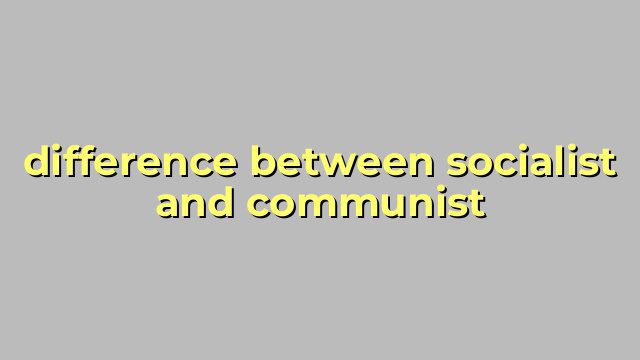Understanding the Key Differences between Socialism and Communism
Socialism and communism are often used interchangeably, but they are not the same thing. While both are systems that advocate for social equality, there are a few key differences between the two concepts. Understanding these differences can help clarify what each system represents and how they differ from one another.
What is socialism?
Socialism is an economic system that aims to promote social equality through collective ownership of industries and resources. The basic idea behind socialism is that wealth and resources should be distributed evenly among all people rather than concentrated in the hands of a select few individuals or businesses.
In a socialist system, the government or a cooperative organization controls the means of production, which includes things like factories, land, and infrastructure. The profits from these industries are then distributed among the members of society according to their needs.
What is communism?
Communism is a more extreme form of socialism that takes things a step further. In a communist system, all industries and resources are owned and controlled by the government. The goal of communism is to create a classless society in which everyone shares equally in the nation’s wealth and resources.
Communism typically involves a centrally planned economy, with the government deciding how to allocate resources and produce goods and services. Unlike socialism, communism seeks to eliminate private property altogether and create a society where everything is owned by everyone.
The Key Differences between Socialism and Communism
One of the biggest differences between socialism and communism is the role of the government. In a socialist system, the government plays a significant role in managing the economy and ensuring that resources are distributed fairly. However, there is still some allowance for private enterprise and ownership.
In contrast, communism emphasizes complete government control over all aspects of society, including the economy. Private enterprise and property are prohibited, and the government controls all resources and means of production.
Another key difference between the two systems is their approach to social and economic inequality. Socialism aims to reduce inequality by redistributing wealth and resources among all members of society. This is typically done through progressive taxation, social welfare programs, and collective ownership of industries.
Communism goes a step further by seeking to eliminate social and economic inequality completely. Since all members of society own everything collectively, there is no opportunity for wealth or power to be concentrated in the hands of a select few.
Conclusion
While socialism and communism share some similarities, they are fundamentally different systems. Socialism seeks to reduce inequality and promote social equality through collective ownership and shared resources. Communism, on the other hand, aims to create a classless society by eliminating private property and giving complete control to the government.
In the real world, neither socialism nor communism has been able to achieve their stated goals completely. Each system has strengths and weaknesses, and most countries have adopted a mixed economic system that incorporates elements of both socialism and capitalism. Understanding the differences between these systems can help us better understand the complex economic and political landscape we live in.
Table difference between socialist and communist
| Aspect | Socialism | Communism |
|---|---|---|
| Definition | A political and economic system in which the means of production, distribution, and exchange are owned and controlled by the community as a whole, typically through a democratically-elected government. | A political and economic system in which the means of production, distribution, and exchange are owned and controlled by the community as a whole, usually through a single party-state. |
| Role of private property | May exist, but regulated and restricted to prevent concentrations of wealth. | Abolished in favor of communal ownership and control. |
| Economic planning | Government plays a significant role in economic planning and decision-making, but may allow for some market forces to operate. | Central planning is the sole method by which the economy is organized and decisions are made. |
| Class struggle | Acknowledges class struggle, but seeks to mitigate it through collective ownership and democratic government. | Seeks to eliminate class struggle and create a classless society through the abolition of private property and the establishment of a socialist state. |
| Political structure | May allow for multiple political parties and democratic elections. | Typically only allows for one political party and centralized decision-making. |

